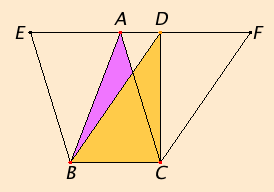Proposition 37
Let ABC and DBC be triangles on the same base BC and in the same parallels AD and BC.

I say that the triangle ABC equals the triangle DBC.
Produce AD in both directions to E and F. Draw BE through B parallel to CA, and draw CF through C parallel to BD.
Then each of the figures EBCA and DBCF is a parallelogram, and they are equal, for they are on the same base BC and in the same parallels BC and EF.
Moreover the triangle ABC is half of the parallelogram EBCA, for the diameter AB bisects it. And the triangle DBC is half of the parallelogram DBCF, for the diameter DC bisects it.
Therefore the triangle ABC equals the triangle DBC.
Therefore triangles which are on the same base and in the same parallels equal one another.